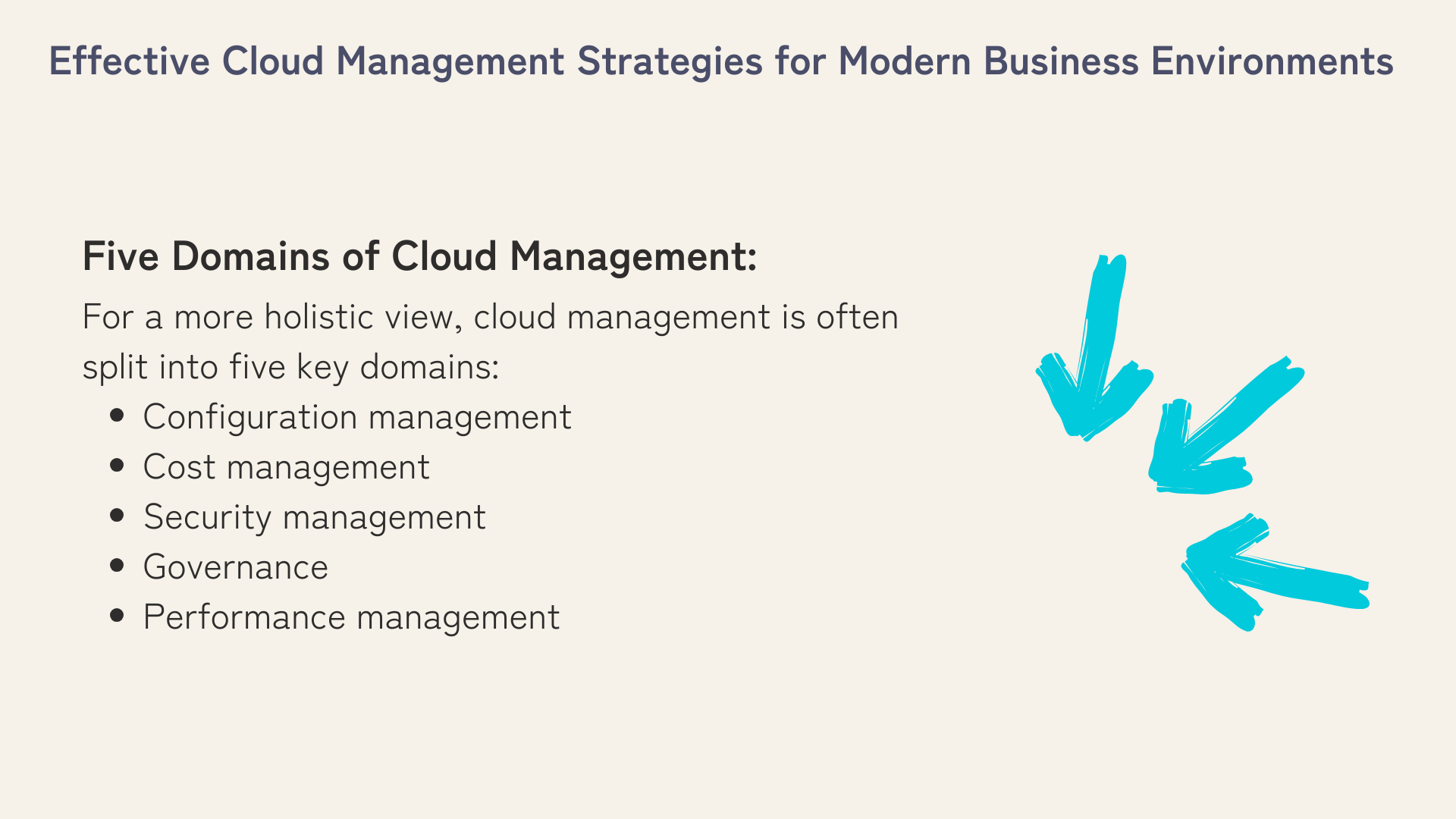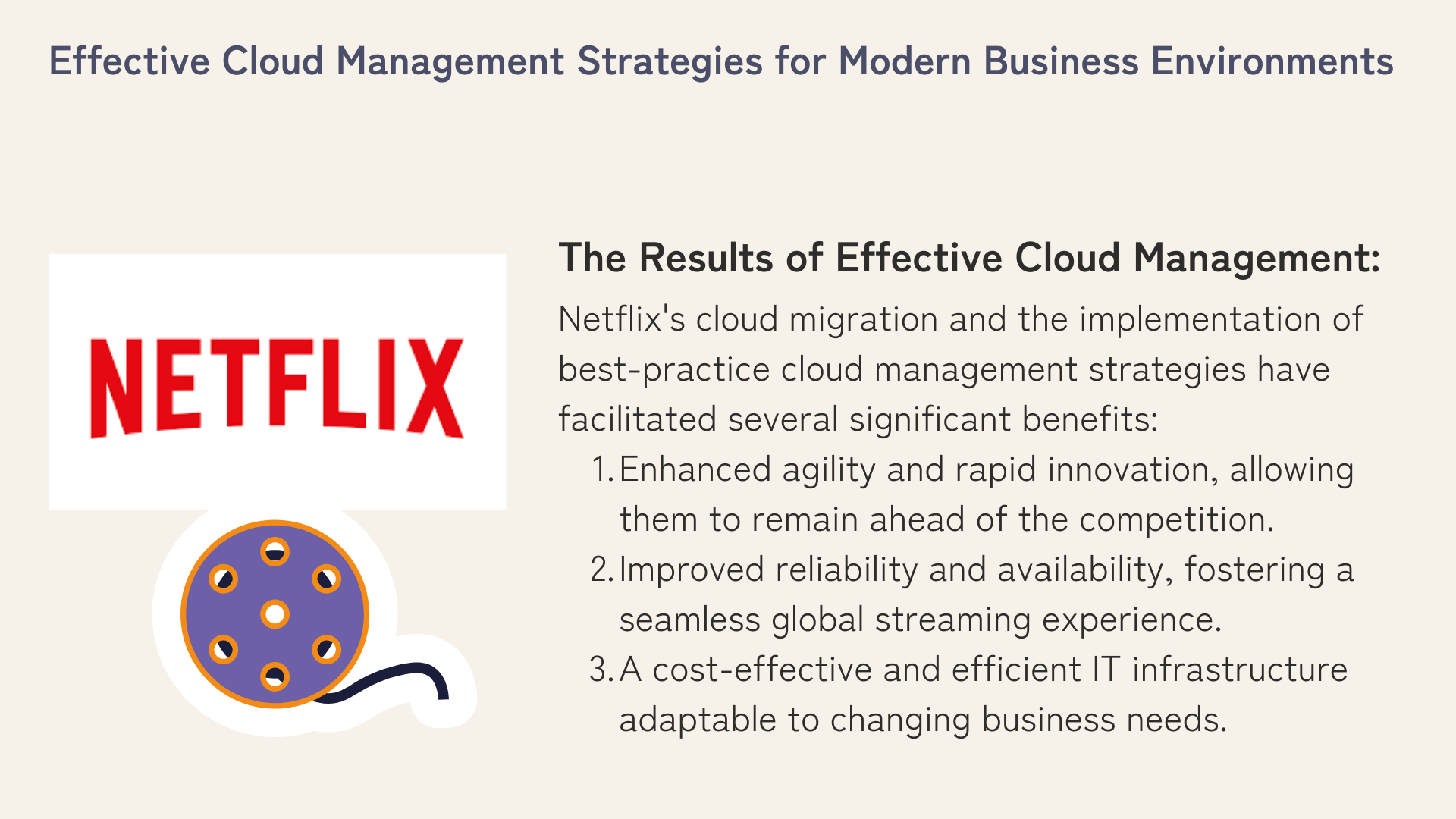Introduction
Cloud management is the overarching administrative process that facilitates the control and operation of cloud computing products and services.
It focuses on aspects like security, compliance, cost management, resource optimization, and overall cloud environment performance.
Given the fast-growing dependence on the cloud, an effective cloud management strategy is essential for any business.
The details may seem overwhelming, yet understanding and implementing effective cloud management strategies can enhance efficiencies, save costs, and provide a significant competitive advantage in the ever-evolving business landscape.
What is Cloud Management?
Simply put, Cloud Management encompasses all the administrative tasks and tools required for the operation of cloud computing products and services in a single, cohesive ecosystem.
It involves deploying and managing applications, managing data, monitoring performance, ensuring security, and optimizing resources within the cloud environment.
According to Gartner, “By 2025, more than 75% of enterprise-generated data will be created and processed outside data centers and cloud data centers.” This underlines the growing influence and importance of Cloud Management.
Traversing the Five Domains of Cloud Management

- Configuration Management: This involves managing the setup and administration of all resources within an organization's cloud environment. It includes maintaining a consistent operating setup regardless of where or how resources are deployed.
- Cost Management: This focuses on optimizing spendings in the cloud. A 2018 survey by RightScale found that "26% of enterprises (companies with more than 1,000 employees) are wasting more than $6 million a year on cloud spending." Effective cost management helps avoid overspending by tracking cloud expenses and ensuring efficient use of cloud resources.
- Security Management: This involves implementing firewalls, antivirus, intrusion detection systems, data encryption, and other security measures in your cloud environment to safeguard it from potential threats.
- Governance: This is the framework of polices, roles and responsibilities that determine how organizations make IT decisions, particularly regarding their cloud environment. Effective governance ensures accountability and aids in achieving the business’s performance and conformance objectives.
- Performance Management: This observes and manages the service quality delivered by cloud resources. It involves the use of tools for constant monitoring, reporting, and diagnosing of any performance issues.
The Importance of Cloud Management
Maximize Return on Investment (ROI)
Effective cloud management ensures you're only paying for the resources your business uses.
By monitoring and controlling your organization's cloud usage, you remove unnecessary services and inefficiencies, thus improving your ROI.
Performance Optimization
Cloud management allows enterprises to monitor network performance.
With proper management and continuous monitoring, potential bottlenecks can be spotted and rectified quickly, preventing disruptions in service delivery and improving customer experiences.
Better Cost Management
One of the significant challenges faced by businesses using cloud services is the unpredictability of costs.
Effective cloud management entails clear visibility and control over your cloud budget.
This allows you to better predict and allocate your resources, reducing or eliminating unnecessary cloud costs.
Data Security & Compliance
Perhaps the most crucial aspect of cloud management is data security. With robust cloud management in place, businesses can protect sensitive data, detect potential threats, and mitigate security vulnerabilities.
Additionally, it ensures regulatory compliance, crucial for certain industries for handling sensitive data.
Enhanced Scalability
With cloud management, businesses can rapidly scale resources up or down based on fluctuations in business demand.
This leads to improved operational efficiency and the ability to focus more closely on the organizational strategy.
10 Practical Strategies for Effective Cloud Management
As businesses around the world increasingly adopt cloud technology, effective cloud management strategies become imperative to unlocking its full potential. In this blog section, we'll explore ten practical strategies that can help you manage your cloud infrastructure and optimize your investment.
1. Choose the Right Cloud Service Model
Cloud computing offers different service models, namely Infrastructure as a Service (IaaS), Platform as a Service (PaaS), and Software as a Service (SaaS).
Each model serves specific requirements, and it is crucial to understand and select the model that best aligns with your business goals and needs.
IaaS: Offers computing resources like storage, networking, and virtual machines on a pay-as-you-go basis. Ideal for businesses with fluctuating demands or those looking for more control over their infrastructure. Examples: AWS EC2, Google Compute Engine, and Microsoft Azure VMs.
PaaS: Provides a platform for developers to build, test, and deploy applications without worrying about underlying infrastructure. Suitable for businesses focusing on rapid application development and deployment across multiple platforms. Examples: Google App Engine, Microsoft Azure App Service, and AWS Elastic Beanstalk.
SaaS: Delivers software applications over the internet, eliminating the need for in-house infrastructure or software maintenance. Ideal for businesses looking to streamline their software processes using off-the-shelf solutions. Examples: Salesforce, Microsoft Office 365, and Google Workspace.
2. Define Governance and Compliance Policies
Establishing comprehensive governance and compliance policies is critical in ensuring the security and conformity of your cloud environment.
These guidelines should consider aspects such as data privacy, service-level agreements (SLAs), and regulatory requirements. In addition, cloud management tools can enable organizations to enforce policies consistently across different cloud services.
3. Centralize Cloud Management
Managing multiple cloud services or accounts can become complex and unwieldy.
Centralizing your cloud management simplifies administration by providing a unified view of your cloud resources.
Tools like AWS Organizations, Google Cloud Resource Manager, and Azure Lighthouse can help consolidate cloud management and improve visibility across your cloud environment.
4. Leverage Automation Tools
Automation plays a crucial role in optimizing your cloud management strategy.
Utilize tools and services that automate tasks such as allocating resources, scaling, deployment, and monitoring to improve efficiency and resource utilization.
Popular options include AWS CloudFormation, Google Deployment Manager, and Microsoft Azure Resource Manager.
5. Implement Cost Optimization Strategies
One of the significant challenges in cloud computing is managing costs proactively. To optimize your cloud expenses, consider the following strategies:
- Track and monitor cloud usage to identify areas where resources may be under or overutilized.
- Implement cost allocation tags or labels to attribute costs to specific departments or projects.
- Set up budget alerts and notifications to monitor your expenditure in real-time.
- Choose appropriate payment models, such as reserved instances, spot instances, or pay-as-you-go, depending on your workload requirements.
6. Maximize Performance and Efficiency
Optimizing your cloud infrastructure's performance involves analyzing the efficiency of your architecture, employing best practices, and regularly monitoring for areas of improvement.
Techniques for optimizing performance include:
- Implementing auto-scaling and load balancing to ensure optimal allocation of resources.
- Employing content delivery networks (CDNs) to reduce latency and improve user experience.
- Opting for regionally diverse deployments to minimize latency and reduce the risk of regional outages.
- Adopting microservices architecture to increase flexibility and scalability.
7. Prioritize Data Security
Data security is critical to your organization's reputation and legal compliance.
Ensure robust security measures to protect sensitive data by:
- Implementing data encryption both at rest and in transit.
- Employing identity and access management (IAM) to control user access and permissions.
- Conducting regular security audits and monitoring for potential vulnerabilities.
- Implementing intrusion detection systems (IDS) and intrusion prevention systems (IPS) to safeguard against external threats.
8. Emphasize Disaster Recovery and Business Continuity Plans
Having a comprehensive disaster recovery (DR) and business continuity plan (BCP) in place is essential for safeguarding your organization's data and ensuring uninterrupted operations. Key components of a DR and BCP include:
- Regular data backups and the creation of data recovery points.
- Utilizing redundant systems and multi-region deployments to provide failover options.
- Documenting a detailed DR and BCP plan, including roles, responsibilities, and procedures.
- Periodically testing and updating the plan to ensure its effectiveness.
9. Monitor and Proactively Manage Your Cloud Environment
Continuous monitoring of your cloud environment provides you with valuable insights into various aspects of your infrastructure, including resource usage, performance, and security.
By proactively managing and addressing issues, you can maintain a healthy and efficient cloud environment.
Some cloud-native monitoring tools include AWS CloudWatch, Google Cloud Monitoring, and Microsoft Azure Monitor.
10. Invest in Training and Upskilling Your Team
The success of your cloud management strategy relies heavily on the expertise and skills of your IT team.
Providing your team with the necessary training and resources to stay up-to-date with evolving cloud technologies is essential.
Encourage certifications, attend workshops, and invest in continuous learning to stay ahead of the curve.
The Netflix Cloud Management Success Story
In a world where digital streaming has become the norm, Netflix stands tall as one of the pioneering leaders.
Behind their success story lies their strategic shift to the cloud and the subsequent implementation of effective cloud management strategies.
Let’s examine the details of Netflix's cloud journey and the management strategies that have led to its resounding success.
Netflix's Journey to the Cloud
Netflix's drive to the cloud began in 2008 after they faced severe disruptions due to a major database corruption incident.
Realizing the limitations of their existing infrastructure, they formulated a long-term strategy to transition from traditional data centers to the cloud.
At that time, the notion of a full-scale cloud migration was relatively new and considered risky.
Nevertheless, Netflix took the ambitious step of transitioning its infrastructure to Amazon Web Services (AWS), a public cloud platform.
This significant shift took seven years to complete and culminated in January 2016, when Netflix announced that it had successfully moved its entire customer-facing infrastructure to the cloud.
Implementing Cloud Management Strategies
Behind Netflix's success is a series of carefully designed and implemented cloud management strategies that have propelled it to become the global streaming giant it is today.
1. Microservices Architecture: One of Netflix's primary strategies was to replace their monolithic architecture with a microservices approach.
By dividing complex applications into smaller, independent services, Netflix could manage, develop, and scale each component independently.
This provided them with greater flexibility and agility when deploying new features while reducing the likelihood of single points of failure.
2. Design for Failure and Resilience: Netflix recognized that infrastructure failures are inevitable. Instead of trying to prevent them, they developed a resilience-first strategy.
This involved embracing a mindset that prioritized preparing for and mitigating failures. They engineered their infrastructure to be self-healing, creating redundancies that would allow them to recover quickly from any disruptions.
Netflix also developed the "Chaos Monkey", a software tool designed to intentionally create failures in its production system during business hours.
This allowed Netflix to test and strengthen their systems while also ensuring that its teams were consistently prepared for disruptions.
3. Auto-scaling and Load Balancing: Netflix's cloud management strategy is mindful of their 200 million users, who create significant fluctuations in demand for streaming services.
They developed a dynamic auto-scaling strategy utilizing Amazon’s Elastic Load Balancer (ELB) and Auto Scaling services.
This allowed them to scale their resources according to real-time user demand, ensuring optimal performance while reducing wasteful allocation of resources.
4. Effective Data Storage and Distribution: Given the vast quantities of data generated by Netflix users daily, effective data management is essential for the company.
They employed both Amazon Simple Storage Service (S3) and Amazon's NoSQL database service, DynamoDB, for scalable, distributed data storage.
Moreover, to deliver content efficiently to a global audience, Netflix utilizes Amazon CloudFront and its own content distribution network (CDN), Open Connect, which allows them to provide smooth streaming experiences to users around the world.
5. Proactive Monitoring and Observability: Netflix implemented proactive monitoring and observability using various AWS tools and custom-built solutions.
Tools like Atlas for real-time monitoring and alerting and Vizceral for traffic visualization help Netflix teams detect and respond swiftly to any issues or anomalies in their cloud environment, reinforcing overall reliability.
6. Leveraging AWS Services for Machine Learning: Netflix also invests in cutting-edge capabilities, such as machine learning, to enhance its services.
They utilize AWS tools like Apache Cassandra and Amazon EMR to process and manage large datasets.
This data contributes to the improvement of their content recommendation algorithms and personalization features, driving better user experiences.

Conclusion
Implementing effective cloud management strategies is essential for maximizing your organization's cloud computing investment.
It involves understanding your cloud environment, optimizing resources, ensuring security, and constantly evolving with industry standards.
By implementing successful cloud management strategies, organizations can enhance productivity, save costs and set the stage for innovative growth. Your next step?
Start developing and implementing your own effective cloud management strategy today.








